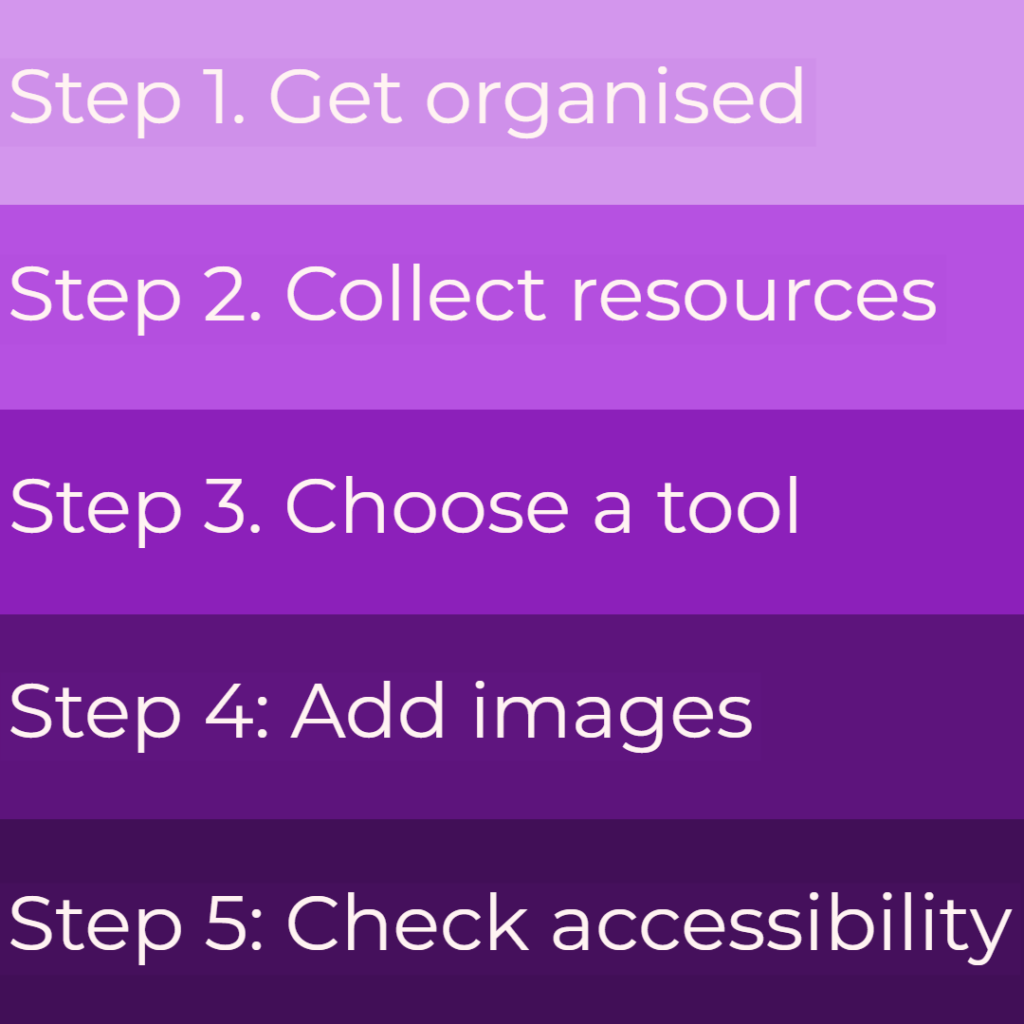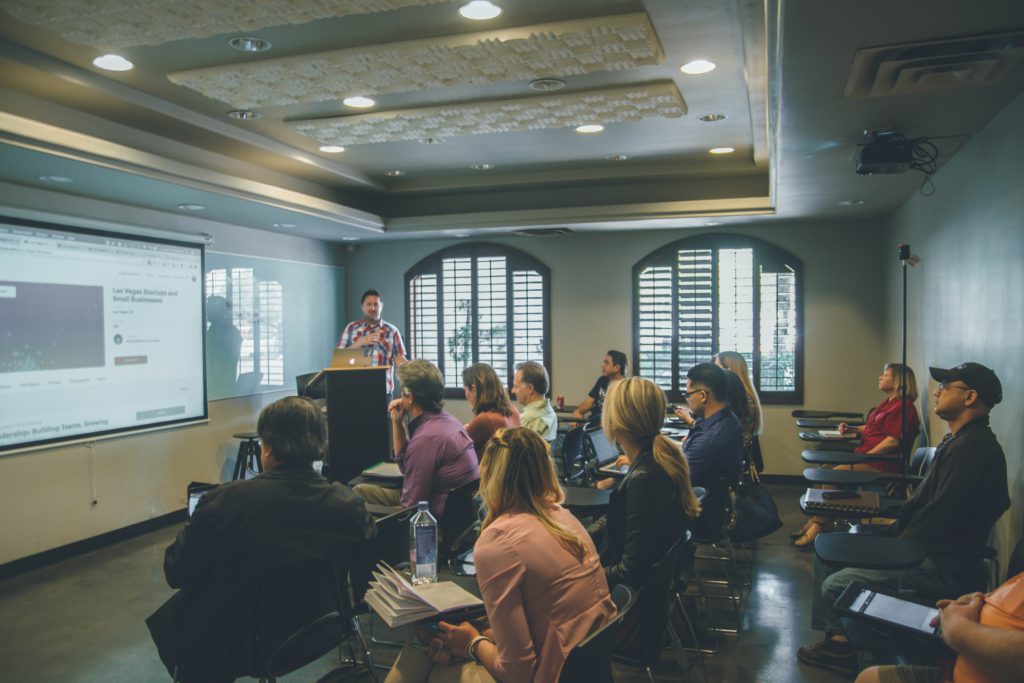
Giving presentations is as much a part of academics’ lives as it is their students’. Whether presenting at a conference or in an undergraduate seminar, there are similar issues to bear in mind and digital tools to help.
Step 1. Get organised
Whether you are creating your presentation alone or as part of a group it is a good idea to have a way of keeping track of the various tasks and stages involved. There are several good task management apps that are free, easy to use, and allow you to allocate tasks to individuals.
The Technology Enhanced Learning team are great fans of Trello. You can share a board with a team, attach documents, add links and due dates. Read more about Trello in ‘The organisational tools I rely on’. Other apps worth looking at are Any.do and Meistertask. All of these work via a web browser and have iOS and Android apps so you can keep track of what’s happening with your project on mobile devices.
Step 2. Collect resources and ideas
Before you start creating your presentation you will want to gather your ideas and materials and those are likely to be a combination of digital materials and paper-based resources. There are several digital tools that will allow you to collect, sort and search your materials.
- Notes. As staff and students at the University of Sussex have access to Office 365, a good option would be OneNote. You can read more about that is our post 5 Great reasons for students to use OneNote.
- Bookmarking. Diigo remains a good option for collecting bookmarks to online content. The free plan allows you 1000 bookmarks or notes and 5 ‘outliners’ or lists, Here is an example of a collection of resources in a Diigo outliner.
- Scanning. If you want to save paper-based resources in a digital format then there are many tools for scanning using a phone or tablet. Apple devices can scan using Notes, you can scan with Google Drive and Microsoft Office Lens lets you add scans to OneNote.
- Mind Maps. It is useful to visualise your ideas and the connections between them in a mindmap. Sussex staff and students can use Mindview which works well with PowerPoint allowing you to turn your mindmap into a presentation. If you want to collaborate on a mindmap or use mobile devices, try Mindmeister or bubbl.us.
- Padlet. This versatile tool allows you to add a range of materials (text, files, weblinks, video, audio, images etc.) to a board and arrange them. Read more in Padlet Backpack for staff and students.
Step 3. Choose a presentation tool
When we think of a presentation we might automatically think of PowerPoint. This well-established tool has its detractors, but generally the faults lie in the way the tool has been used. As long as your presentation is well planned and clearly presented, PowerPoint remains a great option. Here are some alternatives you might want to consider:
- Google Slides is similar to PowerPoint and has some great collaboration and editing functions.
- SMARTboards. If you are presenting in one of the teaching rooms at the University of Sussex where a SMARTboard is installed you can use the Smart Notebook software to prepare a presentation.
- Infographics. Sometimes data is best presented as a poster, in which case you might want to look at infographic authoring tools such as Piktochart or Canva.
Our post on 5 Top Tips for creating inclusive presentations looked at a range of presentation tools and how accessible they are.

Step 4: Add images
Images can add a lot to a presentation – as the adage goes: ‘A picture is worth a thousand words’. There is some confusion around which online images you can use in your work, but don’t forget that images are born copyrighted just as written work is, so you cannot use all images found online. To find images that you can use in your presentation try:
- Creative Commons. A lot of people apply Creative Commons licences to their work so that others can use them. Many of the images found via a search for reusable images will be licensed using one of the Creative Commons licences. You can learn more about the licences in our post Understanding Creative Commons Licences and this resource on how to properly attribute images. You can search for free content in the public domain and under Creative Commons licenses at search.creativecommons.org/
- Google. Search for images using the ‘usage rights’ filter to see images that are labeled for reuse.
- Public domain and other licences. A number of sites bring together collections of images which can be used without attribution. These usually use the CC0 Public Domain licence or a company’s own licences. The best places to find these are:
Step 5: Check that your presentation is accessible
It has always been good practice to make your presentations accessible to all, but new accessibility requirements for public sector bodies mean that this is now essential for digital resources. Although presentations often happen first in a face-to-face setting, slides are usually shared online so it is important that they work well for everyone. The TEL team have created some great resources and guidance on the Digital Accessibility web pages which will take you through creating accessible materials, checking existing documents, finding out about assistive technologies and learning more about specific accessibility needs. In terms of presentations, it is important to:
- Choose a presentation tool that will help you make your slides accessible, such as PowerPoint or Google Slides. Some newer tools such as Prezi, Haiku Deck and Adobe Spark offer some exciting visual features, but do not always have the accessibility options that are required.
- Use an accessible theme and predefined layouts. PowerPoint and Google Slides both have a range of themes that will create easy to read slides and make it easier for you to make your slides accessible.
- Add alternative text to images. If you have images which convey meaning then it is important to provide the ‘alternative text’ that will allow people using screen readers to understand what is in the image. PowerPoint and Google Slides both allow you to add alternative text to images easily.
- Make sure the content is in the right order. When there are several elements on a slide screen readers will usually read them in the order you added them, rather than in the order that makes sense, but you can check and reorder elements.
You can read more about this in 5 Top Tips for creating inclusive presentations which includes step-by-step guidance.


